REPORT MANAGEMENT AND APPLICATION OF HEALTH DATA FOR DECISION-MAKING
VerifiedAdded on 2019/10/30
|6
|1353
|436
Report
AI Summary
The report discusses two hospital funding models: per diem and casemix. Per diem provides a fixed cash amount for a patient's day in the hospital, regardless of expenses incurred, while casemix assigns funds based on activities performed by hospitals and types of patients treated. The report highlights the pros and cons of each model, including increased transparency and incentives for unnecessary care provision with casemix, but also higher costs and administrative complexities. The casemix model is recommended as a suitable funding system for UTS hospital due to its ability to monitor and manage healthcare funding.
Contribute Materials
Your contribution can guide someone’s learning journey. Share your
documents today.
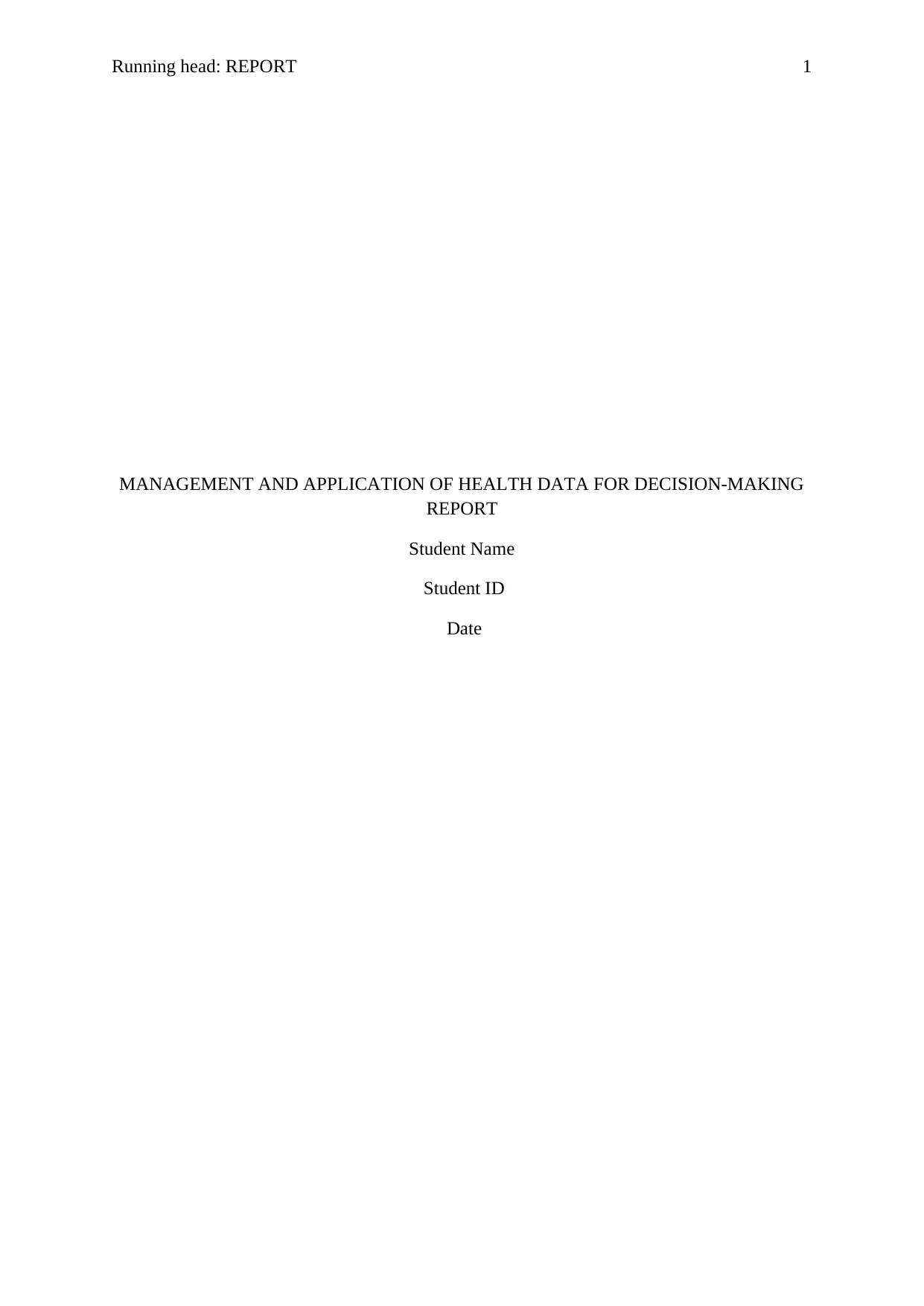
Running head: REPORT 1
MANAGEMENT AND APPLICATION OF HEALTH DATA FOR DECISION-MAKING
REPORT
Student Name
Student ID
Date
MANAGEMENT AND APPLICATION OF HEALTH DATA FOR DECISION-MAKING
REPORT
Student Name
Student ID
Date
Secure Best Marks with AI Grader
Need help grading? Try our AI Grader for instant feedback on your assignments.
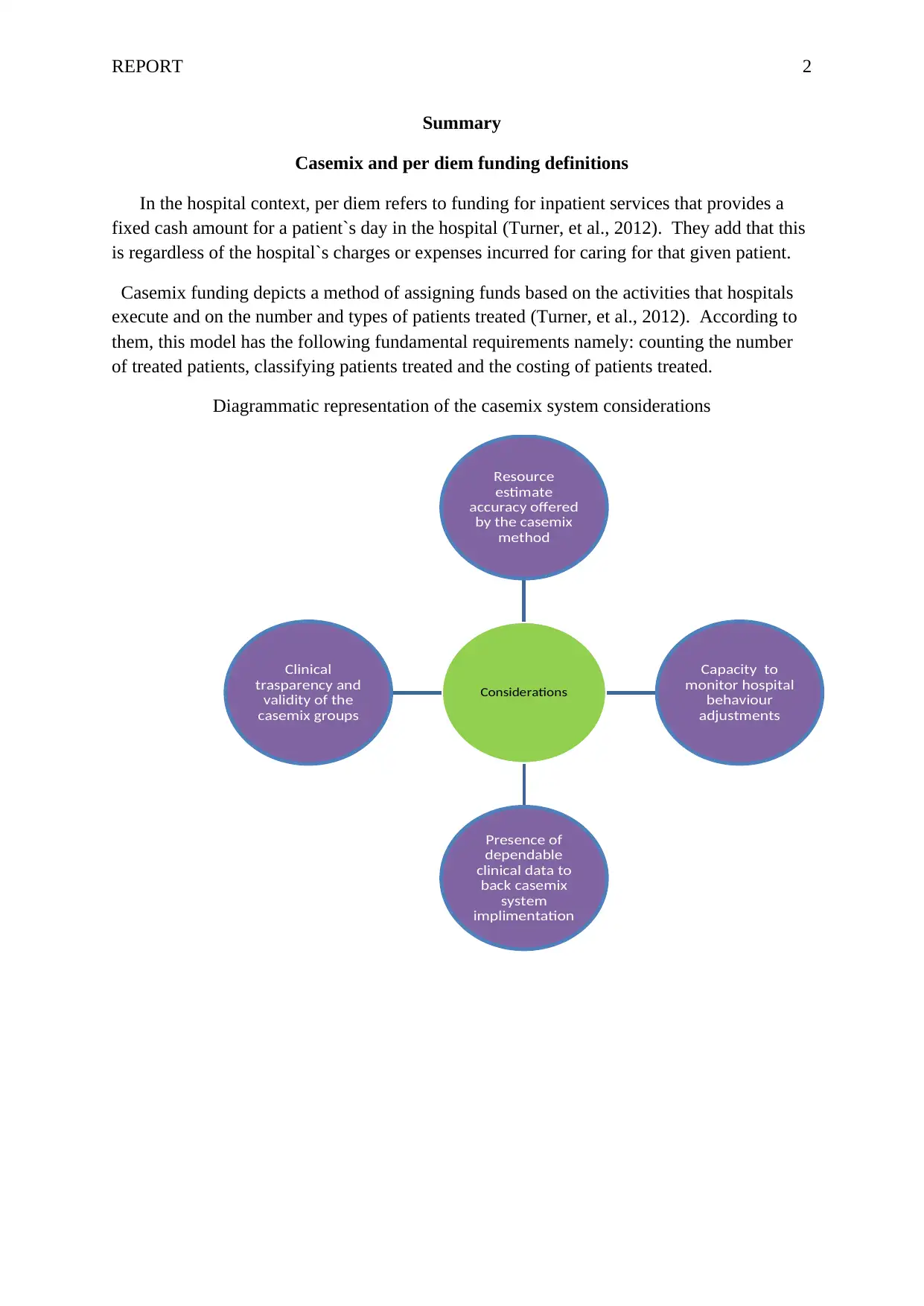
REPORT 2
Summary
Casemix and per diem funding definitions
In the hospital context, per diem refers to funding for inpatient services that provides a
fixed cash amount for a patient`s day in the hospital (Turner, et al., 2012). They add that this
is regardless of the hospital`s charges or expenses incurred for caring for that given patient.
Casemix funding depicts a method of assigning funds based on the activities that hospitals
execute and on the number and types of patients treated (Turner, et al., 2012). According to
them, this model has the following fundamental requirements namely: counting the number
of treated patients, classifying patients treated and the costing of patients treated.
Diagrammatic representation of the casemix system considerations
Considerations
Resource
estimate
accuracy offered
by the casemix
method
Capacity to
monitor hospital
behaviour
adjustments
Presence of
dependable
clinical data to
back casemix
system
implimentation
Clinical
trasparency and
validity of the
casemix groups
Summary
Casemix and per diem funding definitions
In the hospital context, per diem refers to funding for inpatient services that provides a
fixed cash amount for a patient`s day in the hospital (Turner, et al., 2012). They add that this
is regardless of the hospital`s charges or expenses incurred for caring for that given patient.
Casemix funding depicts a method of assigning funds based on the activities that hospitals
execute and on the number and types of patients treated (Turner, et al., 2012). According to
them, this model has the following fundamental requirements namely: counting the number
of treated patients, classifying patients treated and the costing of patients treated.
Diagrammatic representation of the casemix system considerations
Considerations
Resource
estimate
accuracy offered
by the casemix
method
Capacity to
monitor hospital
behaviour
adjustments
Presence of
dependable
clinical data to
back casemix
system
implimentation
Clinical
trasparency and
validity of the
casemix groups
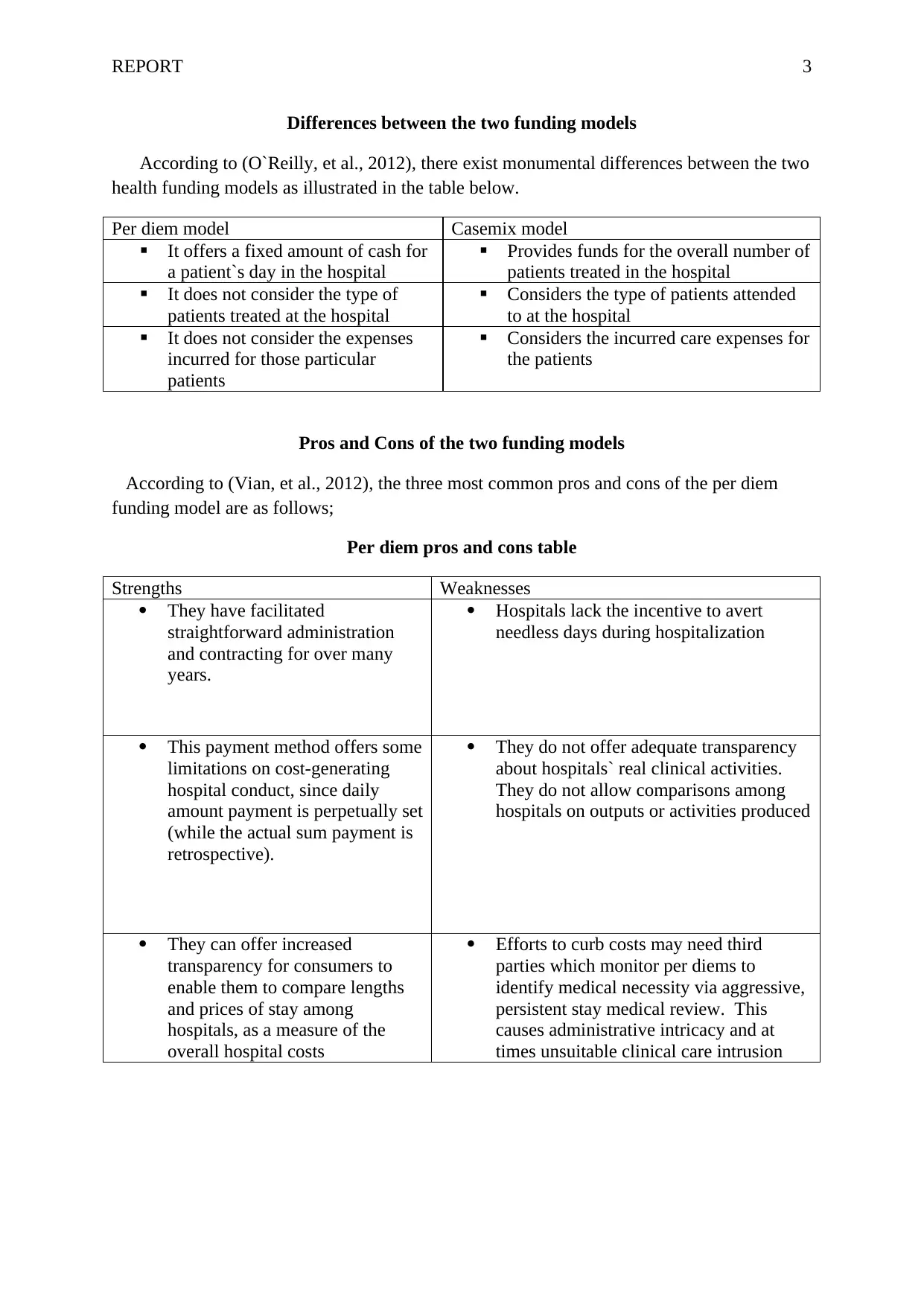
REPORT 3
Differences between the two funding models
According to (O`Reilly, et al., 2012), there exist monumental differences between the two
health funding models as illustrated in the table below.
Per diem model Casemix model
It offers a fixed amount of cash for
a patient`s day in the hospital
Provides funds for the overall number of
patients treated in the hospital
It does not consider the type of
patients treated at the hospital
Considers the type of patients attended
to at the hospital
It does not consider the expenses
incurred for those particular
patients
Considers the incurred care expenses for
the patients
Pros and Cons of the two funding models
According to (Vian, et al., 2012), the three most common pros and cons of the per diem
funding model are as follows;
Per diem pros and cons table
Strengths Weaknesses
They have facilitated
straightforward administration
and contracting for over many
years.
Hospitals lack the incentive to avert
needless days during hospitalization
This payment method offers some
limitations on cost-generating
hospital conduct, since daily
amount payment is perpetually set
(while the actual sum payment is
retrospective).
They do not offer adequate transparency
about hospitals` real clinical activities.
They do not allow comparisons among
hospitals on outputs or activities produced
They can offer increased
transparency for consumers to
enable them to compare lengths
and prices of stay among
hospitals, as a measure of the
overall hospital costs
Efforts to curb costs may need third
parties which monitor per diems to
identify medical necessity via aggressive,
persistent stay medical review. This
causes administrative intricacy and at
times unsuitable clinical care intrusion
Differences between the two funding models
According to (O`Reilly, et al., 2012), there exist monumental differences between the two
health funding models as illustrated in the table below.
Per diem model Casemix model
It offers a fixed amount of cash for
a patient`s day in the hospital
Provides funds for the overall number of
patients treated in the hospital
It does not consider the type of
patients treated at the hospital
Considers the type of patients attended
to at the hospital
It does not consider the expenses
incurred for those particular
patients
Considers the incurred care expenses for
the patients
Pros and Cons of the two funding models
According to (Vian, et al., 2012), the three most common pros and cons of the per diem
funding model are as follows;
Per diem pros and cons table
Strengths Weaknesses
They have facilitated
straightforward administration
and contracting for over many
years.
Hospitals lack the incentive to avert
needless days during hospitalization
This payment method offers some
limitations on cost-generating
hospital conduct, since daily
amount payment is perpetually set
(while the actual sum payment is
retrospective).
They do not offer adequate transparency
about hospitals` real clinical activities.
They do not allow comparisons among
hospitals on outputs or activities produced
They can offer increased
transparency for consumers to
enable them to compare lengths
and prices of stay among
hospitals, as a measure of the
overall hospital costs
Efforts to curb costs may need third
parties which monitor per diems to
identify medical necessity via aggressive,
persistent stay medical review. This
causes administrative intricacy and at
times unsuitable clinical care intrusion
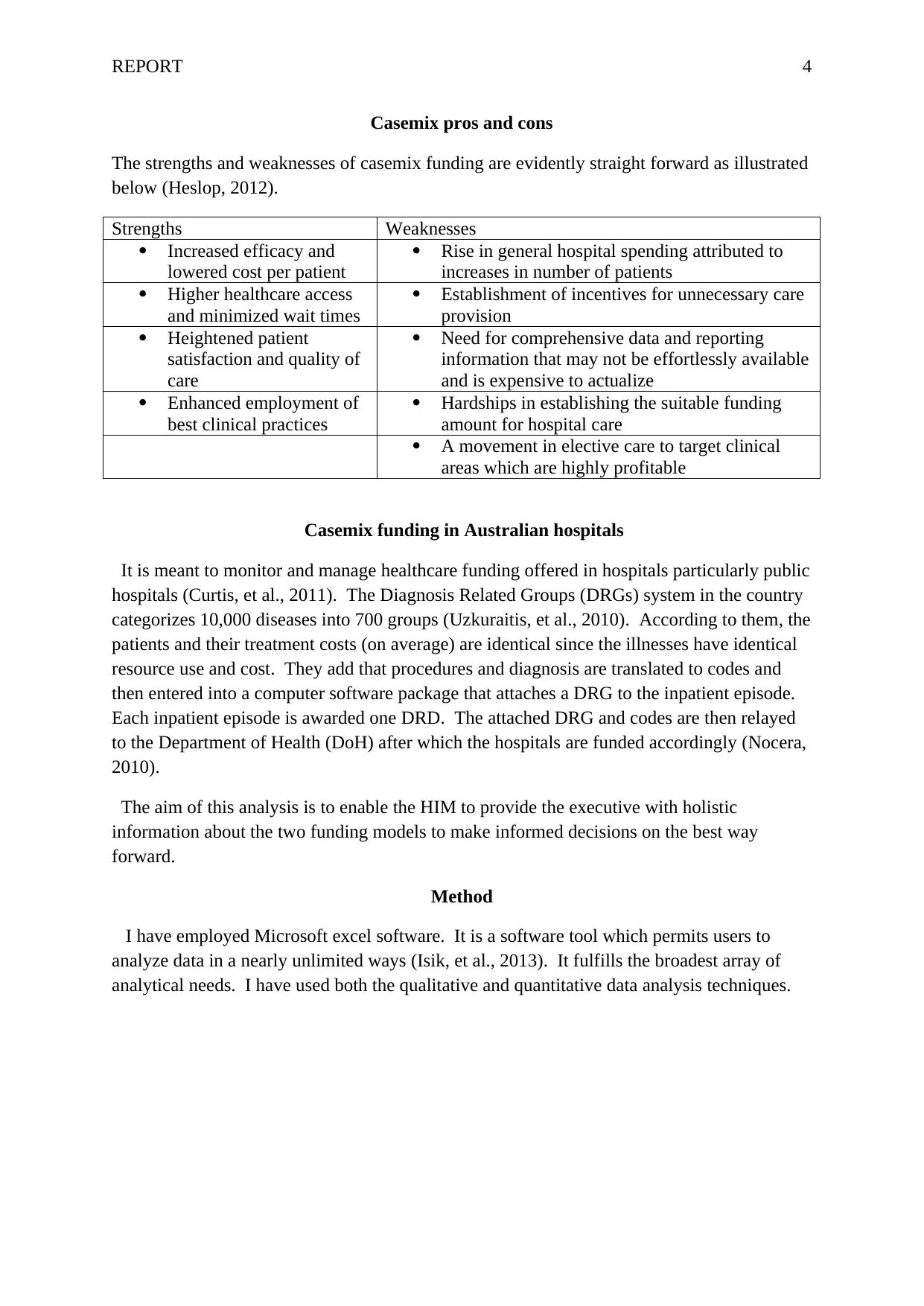
REPORT 4
Casemix pros and cons
The strengths and weaknesses of casemix funding are evidently straight forward as illustrated
below (Heslop, 2012).
Strengths Weaknesses
Increased efficacy and
lowered cost per patient
Rise in general hospital spending attributed to
increases in number of patients
Higher healthcare access
and minimized wait times
Establishment of incentives for unnecessary care
provision
Heightened patient
satisfaction and quality of
care
Need for comprehensive data and reporting
information that may not be effortlessly available
and is expensive to actualize
Enhanced employment of
best clinical practices
Hardships in establishing the suitable funding
amount for hospital care
A movement in elective care to target clinical
areas which are highly profitable
Casemix funding in Australian hospitals
It is meant to monitor and manage healthcare funding offered in hospitals particularly public
hospitals (Curtis, et al., 2011). The Diagnosis Related Groups (DRGs) system in the country
categorizes 10,000 diseases into 700 groups (Uzkuraitis, et al., 2010). According to them, the
patients and their treatment costs (on average) are identical since the illnesses have identical
resource use and cost. They add that procedures and diagnosis are translated to codes and
then entered into a computer software package that attaches a DRG to the inpatient episode.
Each inpatient episode is awarded one DRD. The attached DRG and codes are then relayed
to the Department of Health (DoH) after which the hospitals are funded accordingly (Nocera,
2010).
The aim of this analysis is to enable the HIM to provide the executive with holistic
information about the two funding models to make informed decisions on the best way
forward.
Method
I have employed Microsoft excel software. It is a software tool which permits users to
analyze data in a nearly unlimited ways (Isik, et al., 2013). It fulfills the broadest array of
analytical needs. I have used both the qualitative and quantitative data analysis techniques.
Casemix pros and cons
The strengths and weaknesses of casemix funding are evidently straight forward as illustrated
below (Heslop, 2012).
Strengths Weaknesses
Increased efficacy and
lowered cost per patient
Rise in general hospital spending attributed to
increases in number of patients
Higher healthcare access
and minimized wait times
Establishment of incentives for unnecessary care
provision
Heightened patient
satisfaction and quality of
care
Need for comprehensive data and reporting
information that may not be effortlessly available
and is expensive to actualize
Enhanced employment of
best clinical practices
Hardships in establishing the suitable funding
amount for hospital care
A movement in elective care to target clinical
areas which are highly profitable
Casemix funding in Australian hospitals
It is meant to monitor and manage healthcare funding offered in hospitals particularly public
hospitals (Curtis, et al., 2011). The Diagnosis Related Groups (DRGs) system in the country
categorizes 10,000 diseases into 700 groups (Uzkuraitis, et al., 2010). According to them, the
patients and their treatment costs (on average) are identical since the illnesses have identical
resource use and cost. They add that procedures and diagnosis are translated to codes and
then entered into a computer software package that attaches a DRG to the inpatient episode.
Each inpatient episode is awarded one DRD. The attached DRG and codes are then relayed
to the Department of Health (DoH) after which the hospitals are funded accordingly (Nocera,
2010).
The aim of this analysis is to enable the HIM to provide the executive with holistic
information about the two funding models to make informed decisions on the best way
forward.
Method
I have employed Microsoft excel software. It is a software tool which permits users to
analyze data in a nearly unlimited ways (Isik, et al., 2013). It fulfills the broadest array of
analytical needs. I have used both the qualitative and quantitative data analysis techniques.
Secure Best Marks with AI Grader
Need help grading? Try our AI Grader for instant feedback on your assignments.
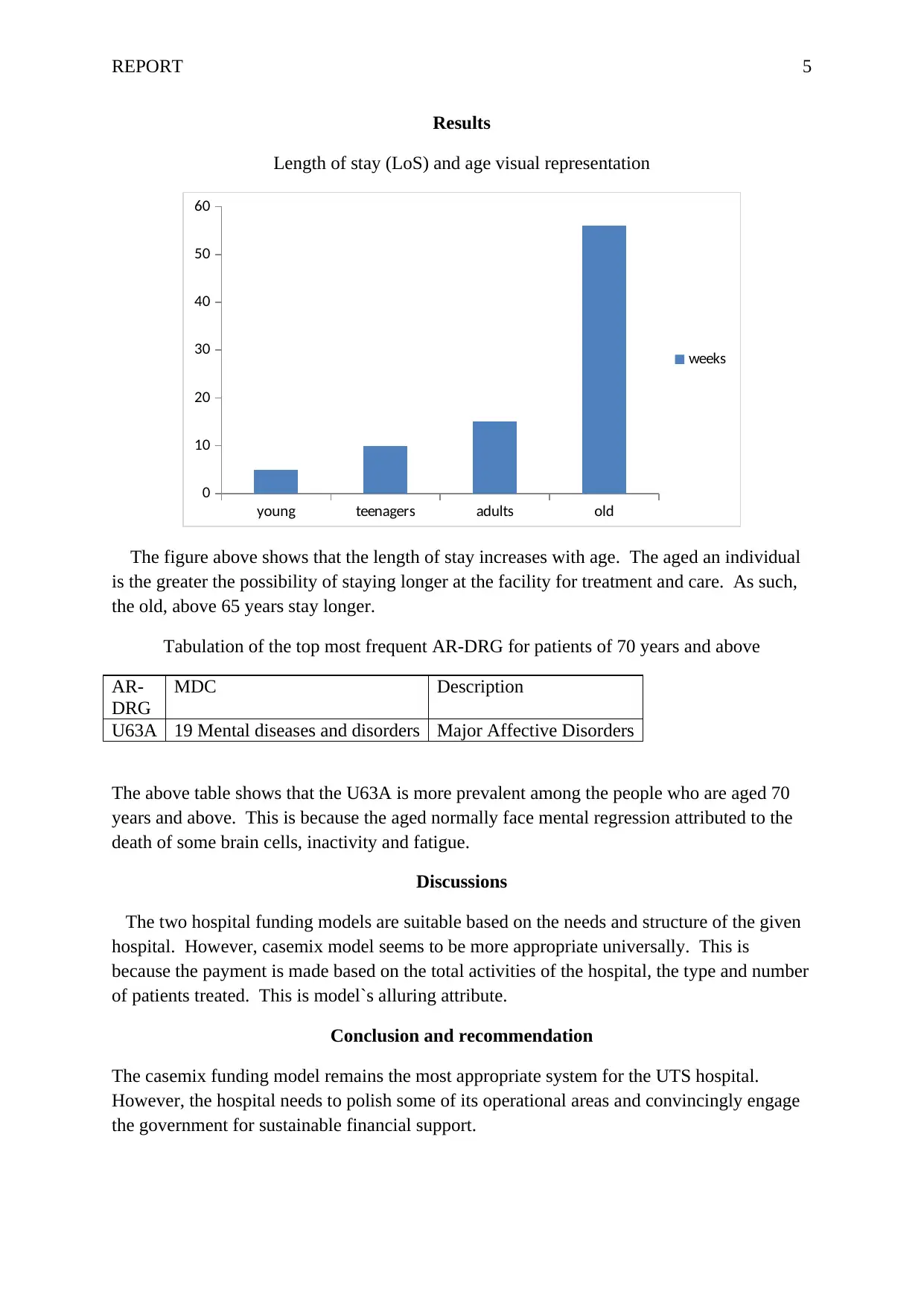
REPORT 5
Results
Length of stay (LoS) and age visual representation
young teenagers adults old
0
10
20
30
40
50
60
weeks
The figure above shows that the length of stay increases with age. The aged an individual
is the greater the possibility of staying longer at the facility for treatment and care. As such,
the old, above 65 years stay longer.
Tabulation of the top most frequent AR-DRG for patients of 70 years and above
AR-
DRG
MDC Description
U63A 19 Mental diseases and disorders Major Affective Disorders
The above table shows that the U63A is more prevalent among the people who are aged 70
years and above. This is because the aged normally face mental regression attributed to the
death of some brain cells, inactivity and fatigue.
Discussions
The two hospital funding models are suitable based on the needs and structure of the given
hospital. However, casemix model seems to be more appropriate universally. This is
because the payment is made based on the total activities of the hospital, the type and number
of patients treated. This is model`s alluring attribute.
Conclusion and recommendation
The casemix funding model remains the most appropriate system for the UTS hospital.
However, the hospital needs to polish some of its operational areas and convincingly engage
the government for sustainable financial support.
Results
Length of stay (LoS) and age visual representation
young teenagers adults old
0
10
20
30
40
50
60
weeks
The figure above shows that the length of stay increases with age. The aged an individual
is the greater the possibility of staying longer at the facility for treatment and care. As such,
the old, above 65 years stay longer.
Tabulation of the top most frequent AR-DRG for patients of 70 years and above
AR-
DRG
MDC Description
U63A 19 Mental diseases and disorders Major Affective Disorders
The above table shows that the U63A is more prevalent among the people who are aged 70
years and above. This is because the aged normally face mental regression attributed to the
death of some brain cells, inactivity and fatigue.
Discussions
The two hospital funding models are suitable based on the needs and structure of the given
hospital. However, casemix model seems to be more appropriate universally. This is
because the payment is made based on the total activities of the hospital, the type and number
of patients treated. This is model`s alluring attribute.
Conclusion and recommendation
The casemix funding model remains the most appropriate system for the UTS hospital.
However, the hospital needs to polish some of its operational areas and convincingly engage
the government for sustainable financial support.
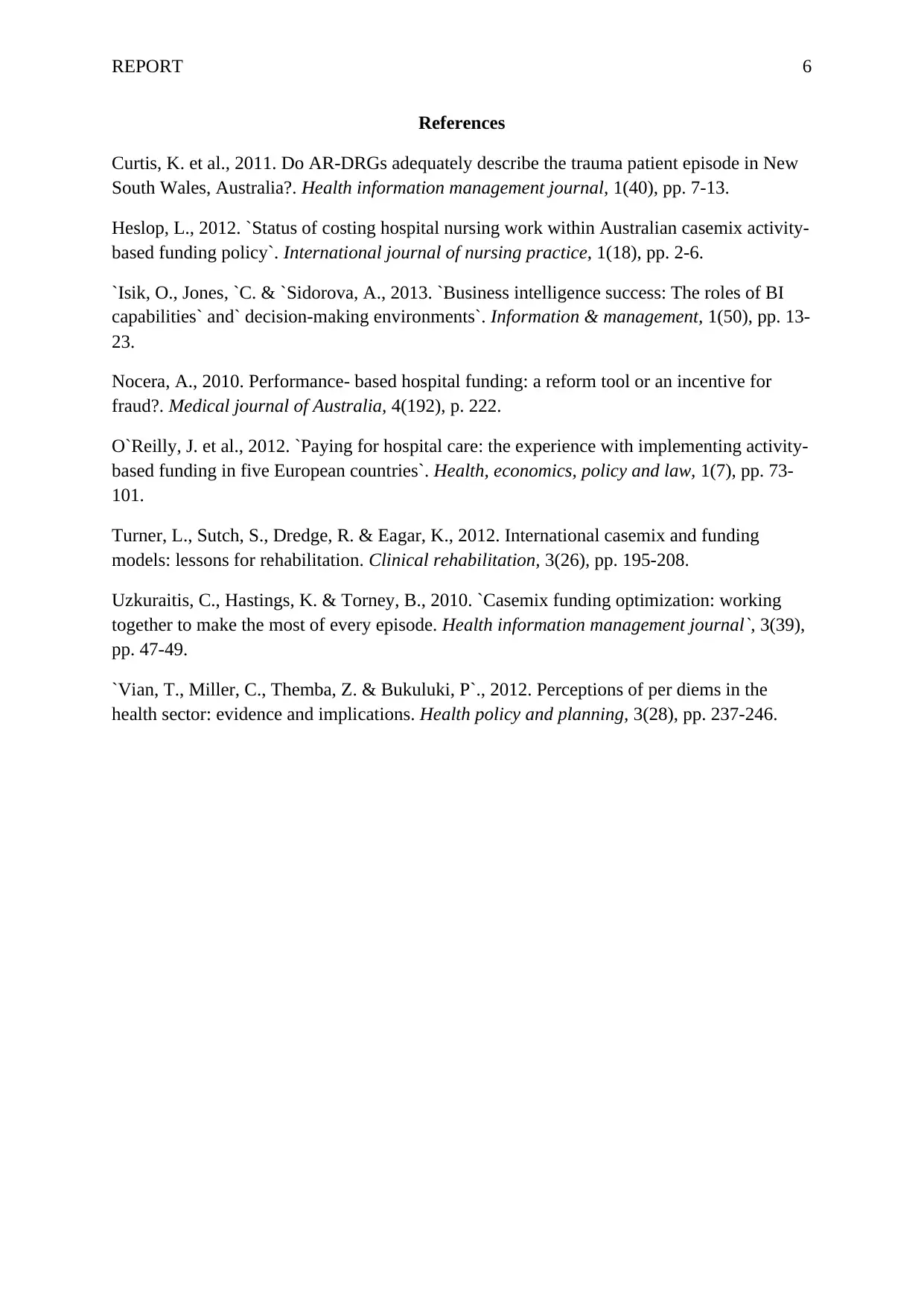
REPORT 6
References
Curtis, K. et al., 2011. Do AR-DRGs adequately describe the trauma patient episode in New
South Wales, Australia?. Health information management journal, 1(40), pp. 7-13.
Heslop, L., 2012. `Status of costing hospital nursing work within Australian casemix activity-
based funding policy`. International journal of nursing practice, 1(18), pp. 2-6.
`Isik, O., Jones, `C. & `Sidorova, A., 2013. `Business intelligence success: The roles of BI
capabilities` and` decision-making environments`. Information & management, 1(50), pp. 13-
23.
Nocera, A., 2010. Performance- based hospital funding: a reform tool or an incentive for
fraud?. Medical journal of Australia, 4(192), p. 222.
O`Reilly, J. et al., 2012. `Paying for hospital care: the experience with implementing activity-
based funding in five European countries`. Health, economics, policy and law, 1(7), pp. 73-
101.
Turner, L., Sutch, S., Dredge, R. & Eagar, K., 2012. International casemix and funding
models: lessons for rehabilitation. Clinical rehabilitation, 3(26), pp. 195-208.
Uzkuraitis, C., Hastings, K. & Torney, B., 2010. `Casemix funding optimization: working
together to make the most of every episode. Health information management journal`, 3(39),
pp. 47-49.
`Vian, T., Miller, C., Themba, Z. & Bukuluki, P`., 2012. Perceptions of per diems in the
health sector: evidence and implications. Health policy and planning, 3(28), pp. 237-246.
References
Curtis, K. et al., 2011. Do AR-DRGs adequately describe the trauma patient episode in New
South Wales, Australia?. Health information management journal, 1(40), pp. 7-13.
Heslop, L., 2012. `Status of costing hospital nursing work within Australian casemix activity-
based funding policy`. International journal of nursing practice, 1(18), pp. 2-6.
`Isik, O., Jones, `C. & `Sidorova, A., 2013. `Business intelligence success: The roles of BI
capabilities` and` decision-making environments`. Information & management, 1(50), pp. 13-
23.
Nocera, A., 2010. Performance- based hospital funding: a reform tool or an incentive for
fraud?. Medical journal of Australia, 4(192), p. 222.
O`Reilly, J. et al., 2012. `Paying for hospital care: the experience with implementing activity-
based funding in five European countries`. Health, economics, policy and law, 1(7), pp. 73-
101.
Turner, L., Sutch, S., Dredge, R. & Eagar, K., 2012. International casemix and funding
models: lessons for rehabilitation. Clinical rehabilitation, 3(26), pp. 195-208.
Uzkuraitis, C., Hastings, K. & Torney, B., 2010. `Casemix funding optimization: working
together to make the most of every episode. Health information management journal`, 3(39),
pp. 47-49.
`Vian, T., Miller, C., Themba, Z. & Bukuluki, P`., 2012. Perceptions of per diems in the
health sector: evidence and implications. Health policy and planning, 3(28), pp. 237-246.
1 out of 6
Related Documents
Your All-in-One AI-Powered Toolkit for Academic Success.
+13062052269
info@desklib.com
Available 24*7 on WhatsApp / Email
![[object Object]](/_next/static/media/star-bottom.7253800d.svg)
Unlock your academic potential
© 2024 | Zucol Services PVT LTD | All rights reserved.




